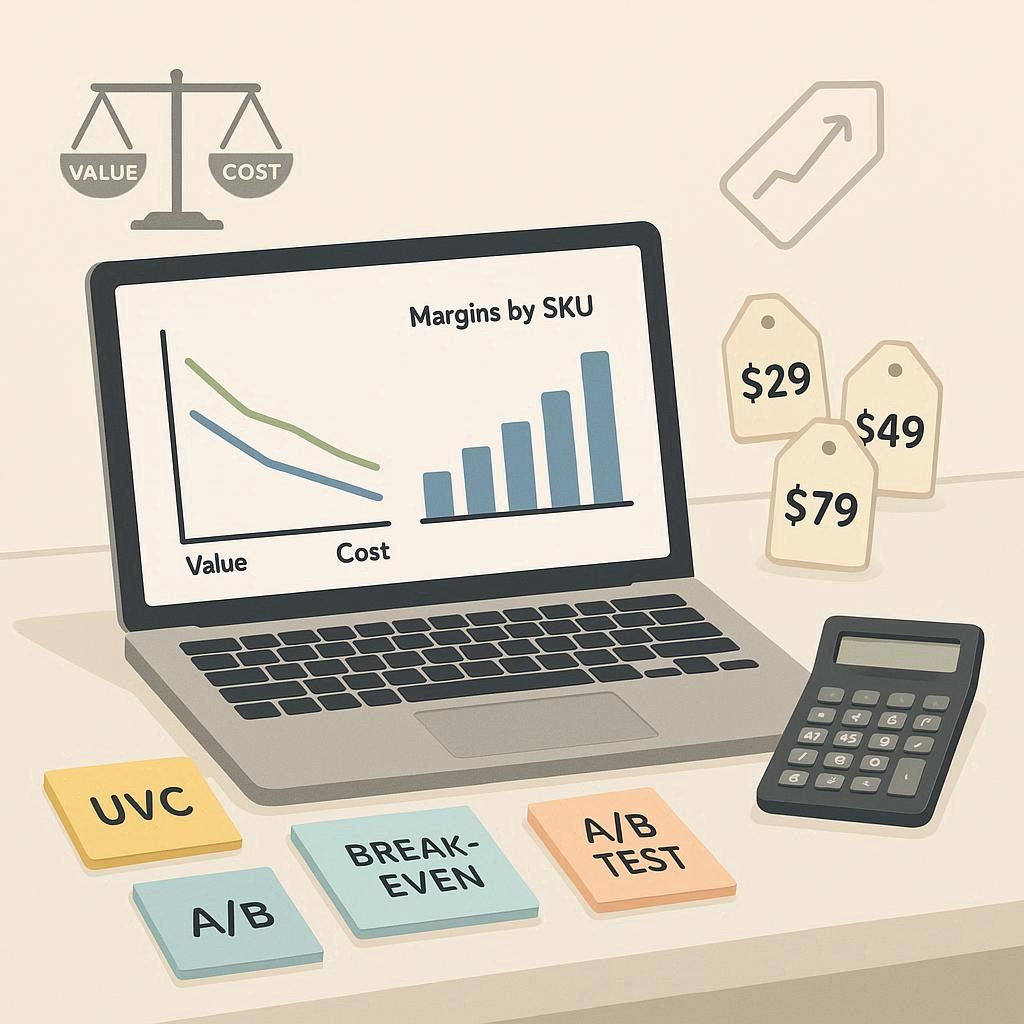Pricing isn’t just a number—it’s a story about value, costs, competition, and your goals. Get it right and you unlock margin, positioning, and growth. Get it wrong and you invite abandoned carts, thin profits, or a race to the bottom. This overview lays out the essential approaches and a simple workflow to move from gut feeling to a repeatable pricing system.
Start with the goal, not the price
Before you touch a spreadsheet, define what pricing should do for you:
- Profit-first: Maximize margin and cash flow.
- Growth-first: Prioritize acquisition and market share.
- Premium positioning: Signal quality and differentiation.
- Inventory turnover: Move stock fast to free up cash.
Your goal will influence every tactic you choose.
Know your floor: costs and break-even
Pricing below cost is a slow leak. Get precise on:
- Unit variable cost (UVC): materials, manufacturing, shipping, payment fees, packaging.
- Fixed costs (FC): salaries, rent, tools, subscriptions (allocated per period).
- Target margin (TM): your required profit percentage.
Useful formulas:
- Break-even price = UVC + (FC / expected units)
- Price for target margin = UVC / (1 − TM)
These are your guardrails; strategy lives between the floor (break-even) and the ceiling (what customers will pay).
Choose a core strategy (and know when to blend)
- Cost-plus: Add a fixed markup to UVC. Simple, predictable, but blind to customer value. Good baseline for low-variance goods.
- Competitor-based: Index to the market (match, undercut, or premium). Use when products are comparable and switching is easy.
- Value-based: Price to perceived outcomes (time saved, status, reliability). Requires research but often yields the healthiest margins.
- Dynamic pricing: Adjust using demand, seasonality, or inventory signals. Best for fast-moving SKUs or constrained supply.
- Tiered/bundled: Create good–better–best options or bundles to serve segments and raise average order value.
Most brands blend cost awareness, competitive context, and value insights.
Use behavioral levers—ethically
People don’t evaluate price in a vacuum:
- Anchoring: Show a higher “compare at” or premium tier to frame value.
- Decoy effect: Add a middle option that nudges buyers to the profitable choice.
- Price endings: .99 can suggest a deal; .00 feels premium. Match to positioning.
- Bundles: Pair high- and low-margin items to improve overall yield.
- Free shipping thresholds: Back-calculate so the margin on the order still holds.
Always be truthful about comparisons and discounts.
Research willingness to pay
You don’t need enterprise tools to get signal:
- A/B test price points on product pages or ads.
- Surveys/interviews: Ask “At what price is this starting to feel expensive?” and “At what price would you question quality?”
- Conjoint/light experiments: Present trade-offs to reveal value drivers.
- Observe behavior: Conversion rate, refund rate, and support tickets post-change are real-world truth.
A simple workflow you can repeat
- Define the objective (profit, growth, premium, etc.).
- Calculate your floor (UVC, FC allocation, target margin).
- Map the market (key competitors, substitutes, gaps).
- Hypothesize a strategy (e.g., value-based with a premium anchor).
- Set initial prices with tiers/bundles that reflect segments.
- Test & measure (conversion, AOV, CAC payback, gross margin).
- Iterate (tighten discounts, adjust thresholds, retire poor performers).
For a deeper step-by-step walkthrough on frameworks and tactics, see this guide on how to price products.
Common pitfalls to avoid
- Copying competitors blindly: Their costs and goals aren’t yours.
- Forgetting fees: Gateways, platforms, and returns erode margin.
- Permanent discounts: Train customers to wait for sales.
- One-size pricing: Different segments value different benefits.
- Set-and-forget: Costs and demand shift; pricing should, too.
What to track after the change
- Gross margin per SKU and blended.
- Price elasticity: %Δ in demand for %Δ in price.
- AOV and attach rate (especially with bundles).
- Refunds/defects sentiment: Price can alter expectations.
- Unit economics by channel: Ads and marketplaces reshape viable price bands.
Done well, pricing becomes a living system—grounded in costs, informed by customers, and tuned by data—rather than a number you hope is right.






